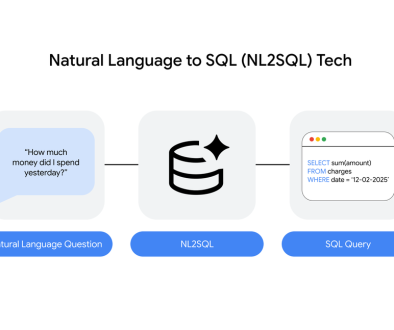GCP – What industry leaders teach us about the future of data
Almost two-thirds of leading organizations claim that creating data-rich platforms is one of the best ways they can “future proof” their business. The research, commissioned by McKinsey & Company highlights that one of the attributes of industry winners is that they don’t just think of data as a component of their business, they act as if “Data is the business”.
What does this mean for your company? How can your team develop practices and perspectives that will allow it to stay ahead of the game?
There’s no doubt that data is the essential ingredient for business transformation across analytical and transactional applications. Once generated, it powers deeper AI-driven business insights, helps companies make better real-time decisions, and is also the basis for how companies build and run their data-driven applications. Google Cloud customers have taught us that there are three key dimensions to a winning data strategy: leaders seek to build architectures that are Open, Intelligent and Flexible. In this blog, we explore what they each mean and how you can apply them.
An Open Approach
While it might be logical to believe that tightly integrated and closed IT environments allow for more value creation through better control, the pace of technology innovation has shown to outstrip a company’s ability to build the solutions its needs from a handful of technologies; let alone get all the data it needs from a single source stored in the same cloud.
In its latest forecast, IDC stated that 2021 would be the year of Multi-Cloud*. This makes sense: whether you’re in manufacturing, retail or healthcare, your business requires that you work with partners who most likely have made choices different from yours: the data you need, the protocols you use and the applications you’ll collaborate around are bound to be heterogeneous. A CIO’s reality is one of multiple interfaces, multiple technology stacks and multiple clouds. And in order to win, she needs to architect environments that are both open and adaptable to this “multiplicity”.
This multiplicity extends beyond the choice of a cloud or a datastore. It also applies to her organization’s ability to build around its partners’ business models. Open-Source is an important consideration of an enterprise modern stack, and as it has been noted numerous times previously, open-source software has the potential to take over the world.
We note that the companies that outpace their competitors’ ability to innovate also partner with vendors who have invested in open-source at their core. By embracing open-source early, industry leaders can contribute to the growth of a wider ecosystem and they benefit from the imagination unleashed by the community faster.
Being open in 2021 means starting from the community up, embracing and enabling its choices across multiple clouds, multiple vendors and multiple business models – commercial and open-source.
For more, we suggest:
-
Three ways Google Cloud delivers on hybrid and multi cloud, today here
-
Bringing multi-cloud analytics to your data with BigQuery Omni here
-
Google Open Source Site here
More Intelligent Insights
Leaders will also find that this “Open” mindset accelerates the operationalization of critical workloads like Artificial Intelligence for example. According to Gartner, “by 2025,50% of enterprises implementing AI orchestration platforms will use open-source technologies, alongside proprietary vendor offerings, to deliver state-of-the-art AI capabilities.”** Being “Open” is thus a key attribute of the “Intelligent Enterprise”.
But, what does it mean to be “Intelligent”? We’ve found that “Intelligence” materializes in two ways at leading organizations. There is “Intelligence in Operation” and “Intelligence in Innovation”.

“Operational Intelligence” refers to the methods used to optimize the operation of infrastructure. A great example of such intelligence can be found in Google’s Active Assist which provides policy, cost, network, compute, data and application platform intelligence. Intelligence in Operation refers to “self-tuning”, “self-healing” or “self-driving” capabilities, and the use of algorithms to increase operational efficiency and reliability.
The second type of intelligence refers to the use of Artificial Intelligence to improve customer experiences and accelerate the creation of insights. Product recommendation solutions can help consumers discover better products and anomaly detection systems can help financial analysts detect fraud faster to protect customers and their company.
I often joke that “A.I” doesn’t just stand for “Artificial Intelligence” but that it also stands for “Applied and Invisible”. The reason for such a pun is that, over the years, I’ve learned from customers that AI has been most useful to them when it was well embedded in the applications that support them and when it is applied to specific business problems and use-cases.
You’ll find that the opportunity to democratize the consumption of artificial intelligence comes by enabling its integration with the applications your users already know and love. Take a look at Veolia (VEOEY), a French transnational utilities company and how it enables its non-technical employees to get answers fast through Data QnA, a natural language interface for analytics.
You might also find the example of PWC familiar to your own needs: the global professional services organization, uses Connected Sheets as part of its efforts to make data more accessible across its workforce. Functionality like Sheets Smart Fill or Sheets Smart Cleanup are additional ways a company can take advantage of Google AI natively built into familiar applications.
When looking for intelligence, look for modern applications that are built from AI and from the Data up. Look for tools that aim at democratizing access to analysis and artificial intelligence to more people. As more people get access to machine learning capabilities in applications they know and love, the faster your company will achieve its goal to become an “Open and Intelligent Enterprise”.
For more, we suggest:
Flexibility of Choice
On the way to building an open and intelligent data architecture, your company might encounter friction. You might find the pricing models of the technologies you need to combine, rigid or incompatible with one another. You might find that certain technologies work well during your evaluation of pilots and at small scale but fail to perform when met with the reality of your fast growing and real-world workloads. And you might find solutions that are effective for batch-level work, don’t work for your real-time needs, forcing you to pull from completely different toolsets to accommodate your needs.
When it comes to pricing, scale and the versatility of functionality, don’t compromise. Choice and Flexibility are key ingredients to your success for the future of enterprise data architecture is composable. According to Gartner, “by 2023, 60% of organizations will combine components from three or more analytics solutions to build business applications infused with analytics that connect insights to actions.”***
Beware the “law of the instrument”
The “composability” trend will have consequences with the types of vendors you decide to partner with. Increasingly you will find that the answer rarely comes from one vendor alone. Rather, value will be created through a well coordinated ecosystem that is both technologically open and offers choice of business models and deployment options.
A key practice industry leaders observe is to “beware the law of the instrument”. The “law of the instrument” or “the law of the hammer” is a cognitive bias that involves an over-reliance on a familiar tool. As Abraham Maslow said in 1966, “I suppose it is tempting, if the only tool you have is a hammer, to treat everything as if it were a nail.“
Industry leaders study their use-cases carefully. They focus on the type of scenarios they aim to enable and the productivity they accelerate by employee category (aka personas). They inspect the core capabilities of the solutions they aim to deploy in order to maximize their effectiveness around what they have been primarily built for (aka ‘center of design’).
Next time a vendor offers its data lake solution to serve as a data warehouse, ask what you will gain and what you will lose. While convergence across these technologies is definitely occurring, your company will need to assess trade-offs before stretching the use of a particular solution beyond its ‘center of design’. Remember, a hammer can do a lot of things but it was primarily built to push down nails. You may also demand that the same product might be licensed to you differently based on your use-cases. Take a look at Google BigQuery pricing options. The same data warehouse product can be used on 3 different constructs: pay per-query (on-demand), allocation (flat-rate) or a mix of both. Another example includes Dataflow FlexRS, a pricing option that reduces batch processing costs by using advanced scheduling techniques.
Examples of organizations that have successfully built Open, Intelligent and Flexible data architectures include Unity combining technologies like Dataproc, Dataflow & BigQuery. Another great example is how Vodafone executes on its vision for a Data Ocean for all users and all data. We hope you can learn from each of the above customers the way we have. Please reach out to our team if there is anything we can do to help you towards a more Open, Intelligence and Flexible World!
For more, we suggest:
*IDC Press Release, IDC Expects 2021 to be the Year of Multi-Cloud as Global COVID-19 Pandemic Reaffirms Critical need for Business Agility, March 2020
**Gartner, Predicts 2021: Operational AI Infrastructure and Enabling AI Orchestration Platforms, Chirag Dekate, et al., 2 December 2020.
***Gartner, Predicts 2021: Analytics, BI and Data Science Solutions — Pervasive, Democratized and Composable, Austin Kronz, et al., 5 January 2021
Read More for the details.






